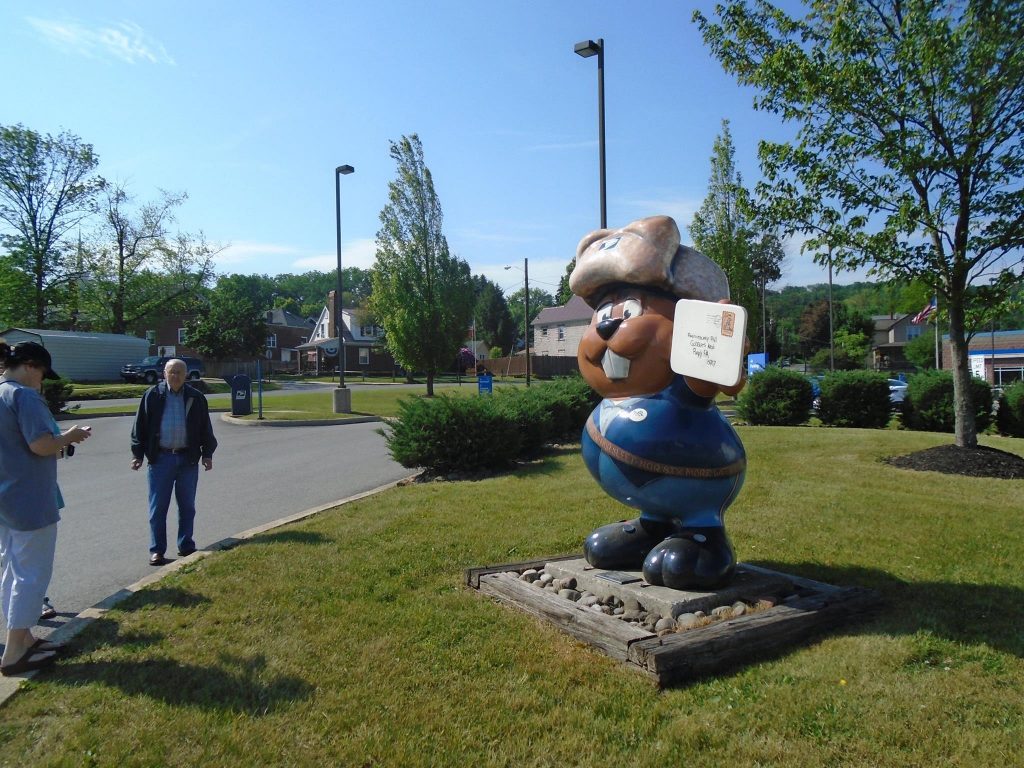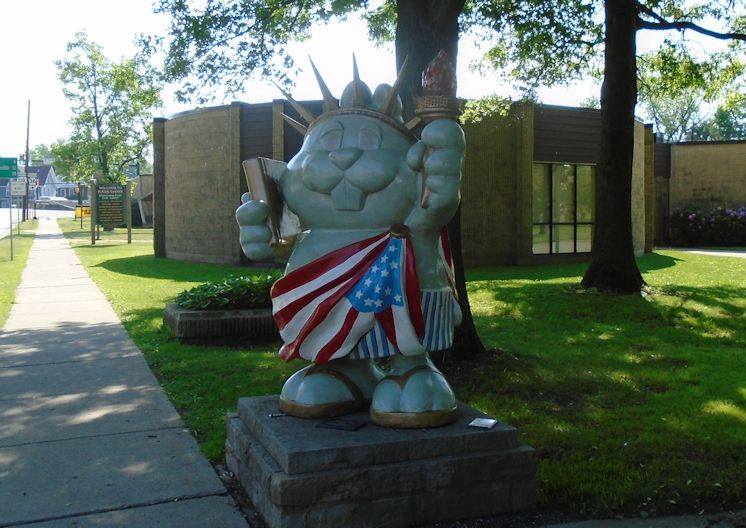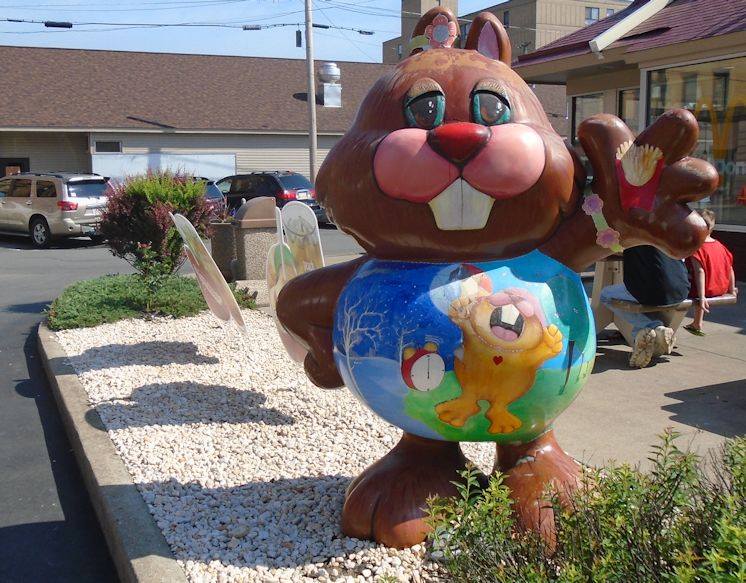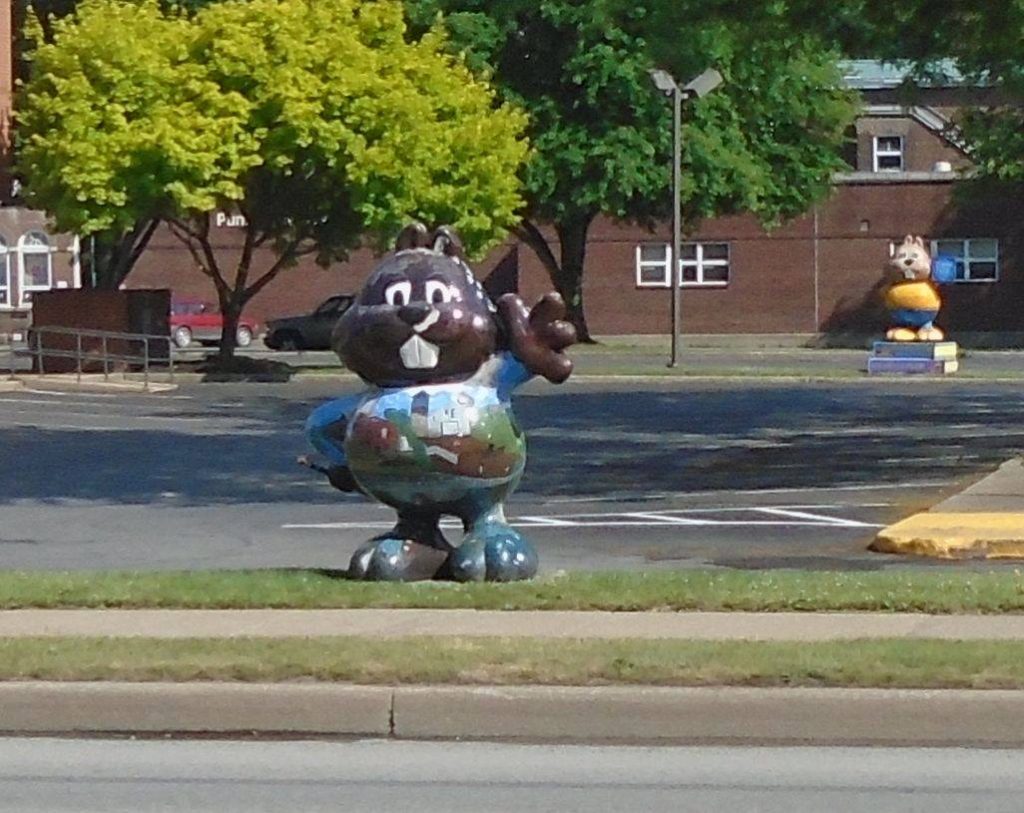Groundhog Day is one of my favorite movies, so we could not miss the chance to stop off in Punxsutawney, even though the movie was not really filmed there. It is a pleasant place, but not very much to see except cartoonish statues of groundhogs all around town.
The bike is back

I broke the fork on my bike and was using Espen’s heavier bike. But I went to Bikenetic in Falls Church. They got a new fork and fixed it up. They could not match the color, but the chrome looks good and I again have the joy of riding my good bike. I get to work about ten or fifteen minutes faster (it takes about an hour on the fast bike) on my road bike and it is more fun to ride.
I bought this bike back in 1997. If this new fork extends the bike’s life for another eighteen years, I will be content. My picture shows my bike at the Federal Center SW Metro stop. You can take your bike on the Metro before 4pm or after 7pm. It is 17 miles along the bike trails I ride from home to work. On the way to work, it is usually a nice ride because it is cooler in the morning, more downhill on the way to Washington and very often the west wind provides a tailwind. I can take a shower at Gold’s Gym and get to work fresh. It is less fun riding home, so I arrange my schedule to leave earlier or later and take advantage of the Metro rules.
When I first discovered that you could take the bike on the Metro, you had to get a special permit. I used to work at the Ops Center and I got off not too long before midnight. I had to rush to the station to make sure I did not miss the last train.
Virginia whiskey and brandy
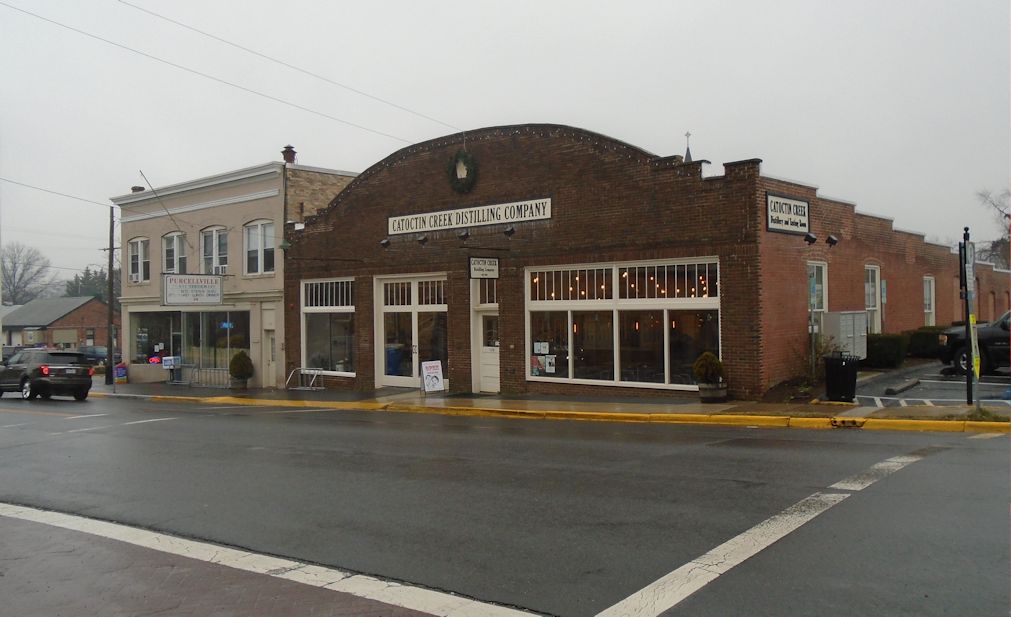
Chrissy and I went to visit the Chrissy & I went up to visit the Catoctin Creek Distilling Company in Purcellville. You can follow the link for details. They make small batches of rye whiskey and brandy, all from locally sourced products. They try to make it a closed loop process. For example, the leftover grain (after the whiskey is made) goes to local farmers, where it is fed to cattle and, according to the tour guide, the meat ends up at the “Market Burger” restaurant across the street.
I am not a great connoisseur of whiskey, although I have learned that I like some more than others. Generally I like bourbon better than rye. Most of the decent bourbon brands are okay. I am not sure I could really tell most of them apart. Scotch can be good, but it depends much more on the brand. I am not fond of brandy, but the Catoctin Creek folks make a brandy called “1757” (the year Loudoun became a county) that is very good. But since I cannot tell very much by the taste, I like the stories. I know that many of the stories are not true, but I like them still. The story of the Catoctin distillery is one of a local business trying to make an ecologically friendly booze. I like that.
The tour was interesting and short. I have been on distillery tours before . We went on the Kentucky Bourbon Tour a few years back. But I learned something interesting. the spirits come out in three groups: the head, the heart and the tail. The head is too strong and that is the stuff that will kill or blind you. The heart is the part they make into whiskey. The tail is too weak to be used directly, but at the Catoctin Distillery they use it as the base for a gin they make. After the tour we had the tasting. As I said, the “1767” brandy was good. My second favorite was Roundstone Rye 97. It was a little too strong. The 97 refers to the proof.
After the tasting, we went over to Market Burger across the street. They were very good, old fashioned burgers. We didn’t notice any of the whiskey flavor in meat that they might in theory have picked up from the whiskey grain feed.
Purcellville is a nice little town. It is the start of the W&OD bike trail.
Recent times
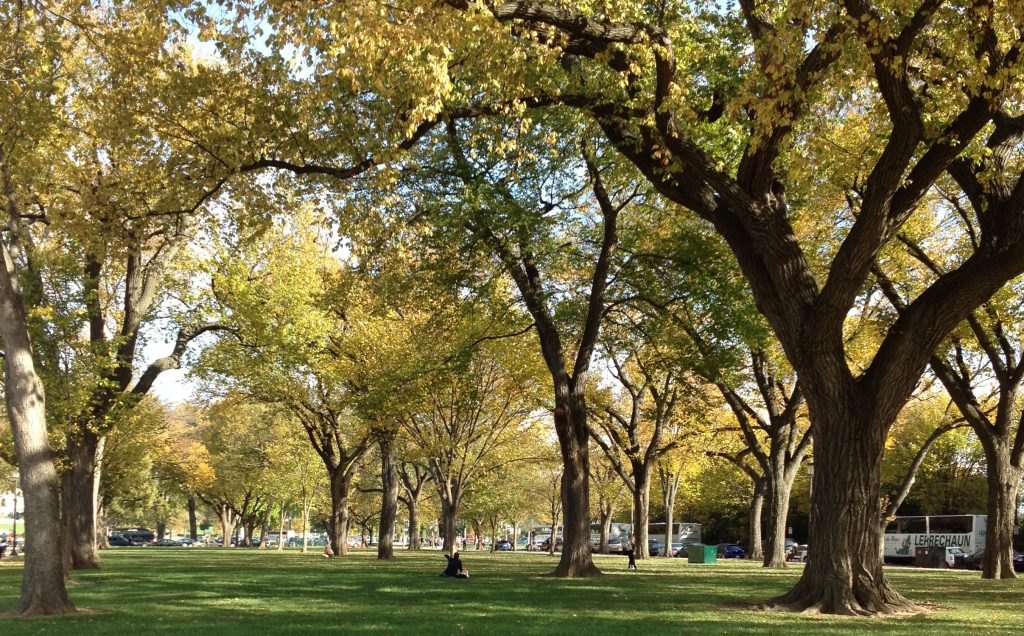
I have not been that busy but I have been putting more onto Facebook. Facebook is much more ephemeral. I generally link to articles I find interesting and make a few comments. I don’t tell much of my experience and I need to get back to that.

Summing up the last couple of months, life has been strange. I feel in between. Smithsonian is a great place to be. I am getting a really good education. State Department is sometimes good about these developmental jobs. I got a lot out of my year at Fletcher School of Law & Diplomacy. It changed my outlook and made me a better diplomat. I think that paid off the State Department over the next ten years. I have no doubt that all the things I am learning at Smithsonian would make me a better diplomat too, but I am at the end of my career now. I will get the benefit, but State will never get the pack back. I think from the strictly practical point of view, they should not have made the investment in me. But …
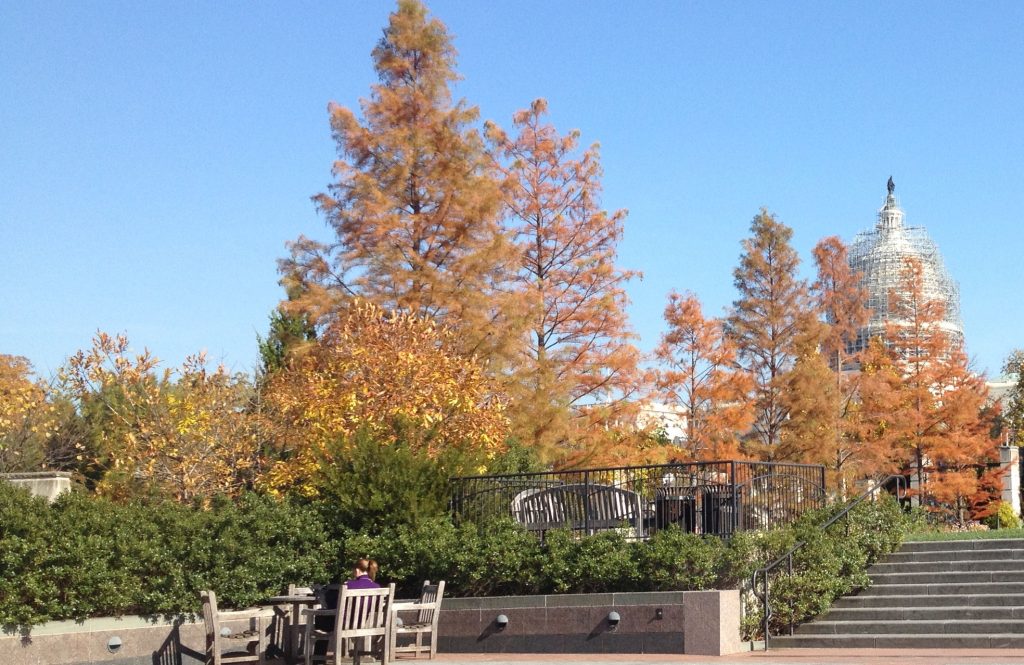
I love Washington and the part I love the most is the area around the Mall, i.e. Smithsonian. It is a great gift that State is giving me.
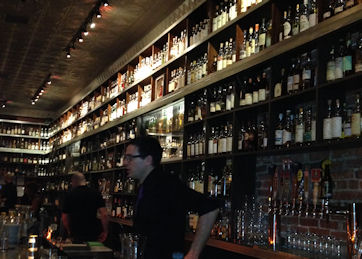
My pictures are some of the leftovers. The top are the elm trees on the Mall from last fall. Next is the Art Museum. Museums should be done slowly. Being on the Mall allows me that. I can go in, spend time in one place and then go. Below that is the National Arboretum with the Capitol in the background. It is a great place to walk at lunchtime. Bottom is Jack Rose Dining Saloon. They have hundreds of whiskeys. I attended a Smithsonian program on whiskey. We go to taste a variety of types and pretend to be learning.
Golden fall

October is one of the best times for Washington. We get crisp clear days, cool and not very humid but sunny. I am taking advantage of this window of beauty, riding my bike to work and walking as much as I can.
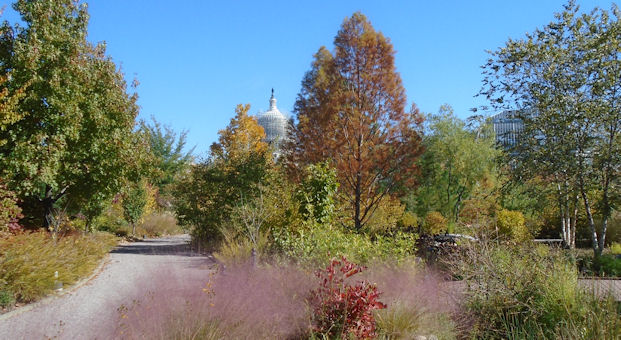
Today I wandered over to the Botanical Gardens at lunchtime. It is a small area but packed with pleasantness. They used plants from around the middle Atlantic region, so we have the familiar longleaf & loblolly pines and lots of oaks and cedars. I just like to be there. You really don’t have to own your own stuff if you can use these nice places. But I also find it humbling. They mark the trees and plants. I pride myself on being able to identify trees, but my pride is misplaced. I can tell the general groups. For example, I can tell a loblolly pine from a longleaf or a white pine. But they have pond pines and pitch pines that I could not separate from the loblolly. I also have trouble telling black oaks from red oaks. When I know that is it a black oak, I can see why it is, difference in leaves etc. but I would be unable to do it in general.

I have also been trying to get to the Smithsonian Museums. The great thing about Smithsonian is that all the museums are free, so you can go in for a short time w/o having to spend the big bucks or feeling that you have to see everything to “make it worth it.” I went to the National Gallery of Art. You could spend a lot of time there. They provide comfortable places to sit surrounded by light and beauty. This is the proper way to appreciate art, taking the time to hang around. I looked at lots of the paintings but I lingered in the Impressionist section. Chrissy likes Monet and Renoir. I am no expert. I could not tell one impressionist from another and don’t expect ever to learn, but I enjoyed the brightness, the light.

We went to see the movie “Fury” over the weekend. It stars Brad Pitt, who looks so much like me. Anyway, it is a very violent movie with scores of people being killed every minute. It takes place in Germany in April, 1945. The war is almost over but there remains desperate resistance, with children and old people pressed into service. I was thinking about that as I walked around my beautiful Washington on a perfect day. Germany was so utterly destroyed by the war. All over Europe centuries of culture and art were lost, stolen or destroyed; life was reduced to its basic elements. The most civilized, progressive and prosperous parts of the world debauched into barbarism that killed millions and brutalized millions more. The Impressionist light was out of place. Washington could be reduced to this someday. It seems impossible now, but I don’t expect the Germans, Poles, French and others really thought it would ever happen to them, or at least not in their lifetimes of that of their children. I think of the Romans watching the Visigoths come over the hills and uttering the Latin equivalent of “Oh shit; what the hell happened?” Nobody for hundreds of years had believed such a thing even remotely possible. We like to think such savagery is in the past, but there are place right now that it is going on like then.
But we cannot let it end like that.
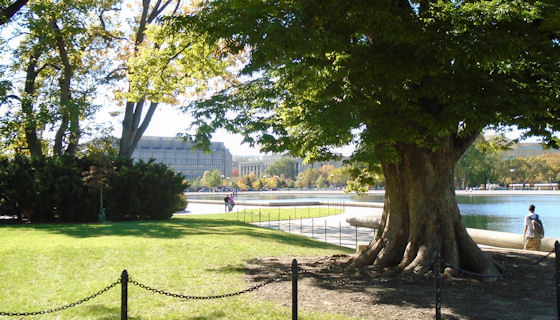
My pictures are from near the Capitol. You can see that they are reconstructing the Capitol Dome. It is made of iron, which has rusted and needs to be fixed. The other pictures are from the Botanical Garden, except the one on the bottom, which is a big zelkova tree near the pool in front of General Grant’s monument. Zelkovas are in the elm family and resemble shorter versions of the American elm in that they have a vase shape. But they tend to be squatter and thicker, as you can see above. They don’t usually get Dutch elm disease, which is why they were planted to replace dying American elms in the 1970s. Washington is a pleasant place most of the time.
W&OD bike trail
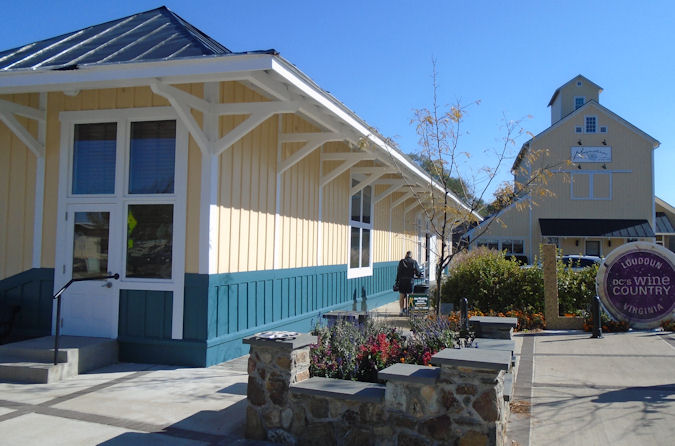
I have been meaning to ride the W&OD trail from the start and finally got around to it. Alex dropped me off at the start of the trail in Purcellville. It was about forty miles to my house. It was a perfect day for it, with temperatures at around 65 degrees and a wind of about eight MPH from west/northwest, i.e. mostly a tailwind.

The trail is pretty flat but tending down from west to east. You can see above the deep cut and they cut into the hills and filled in the low points. W&OD was the Washington and Old Dominion railroad line. Trains were unable to go up grades that were too steep. Standard maximum grade for the 19th century railroads was 2.2% or 110 feet per mile. What was good for trains is good for bikes.
One drawback to the trail is that there are no shops and restaurants right on the trail. I suppose this is not generally a problem. You can find accommodations not very far away, but besides one establishment called Carolina Brothers Barbeque at mile 27 in Ashburn, you don’t have a direct trail access. I stopped at a place called Old Ox Brewery just before mile 25. You had to go a dirt path from the trail, but it seemed a nice place. I had a small beer before going on. You can see from the bike rack that others had similar ideas.

I am glad I finally made the journey. I have been thinking about it since I first discovered the trail back in 1997. I run on part of the trail and I use it to ride my bike to work, but going the other way is harder. It is more uphill and there really is no place to go. I enjoy riding my bike, especially on these nice October days. But I think that when you get much beyond an hour of riding, it becomes more a challenge than just a pleasure. It is one of those things that is good to have done. I doubt I will do it again.
New Deal murals

The Smithsonian Museum of American Art did a program today on the mural art of the New Deal, especially emphasizing the work of Texas Artist Tom Lea. These murals were commissioned by the government during the Great Depression. They were meant to give artists useful work and celebrate America in all its regional diversity. Most were in public buildings such as post offices, which is why they are currently in some peril. Structures from the 1930s are often reaching the end of their useful lives. They are being torn down or converted to other uses.
What I found particularly interesting was the relationships between artists, officials and the people. This art was never meant as a personal expression of an individual artist. They were designed by committee; the community made decisions about themes and sometimes about details. This is what makes them more interesting.
They are not about the artists themselves and their particular vision. They are bigger than the artist. They are indeed about self-expression, but not merely self. Artists were paid in installments. If they produced something their patrons didn’t want, they might not be paid. Maybe because it is not the work of an individual artist, the murals are full of allegory and symbolism. They celebrate the town or region. Since they were meant to be in public places where people would see them every day, they had to make sense to people every day. The government paid the artists, but the work was truly market driven.
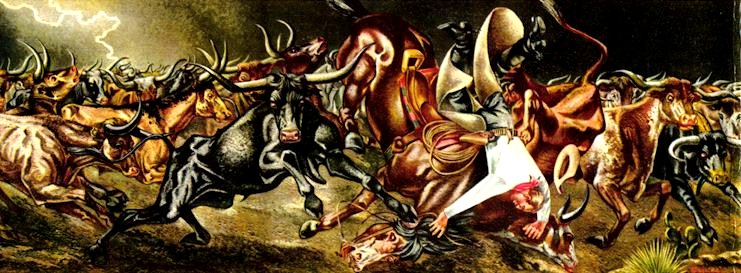
The focus was a case study of the Texas artist Tom Lea and particularly a mural he did called stampede done for the post office in Odessa, Texas. Originally, the mural was high on a wall over the tellers. When people came in, they looked up at it and probably had time to contemplate it while waiting in line. It was moved when a new post office was built nearby, but it was placed in an out-of-the-way place and at eye level. Context is important. Is it really the same work of art in its new location?
Anacostia Community Museum
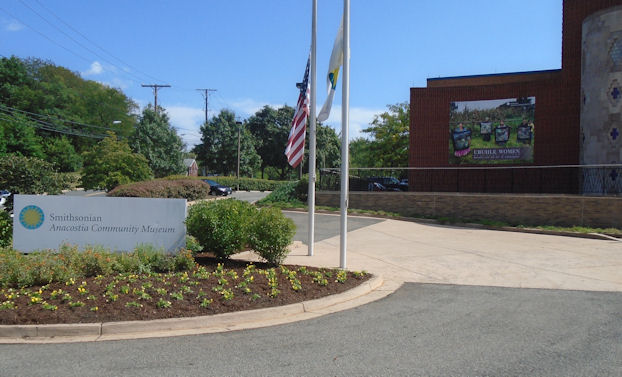
Taxi drivers don’t know how to get to the Anacostia Community Museum, so if you take a taxi be sure to take a printout of the maps and directions. There is a shuttle that runs from the Smithsonian museums on the Mall. It is a distinct disadvantage to be so far from the main flagpole, but it was worth the trip.
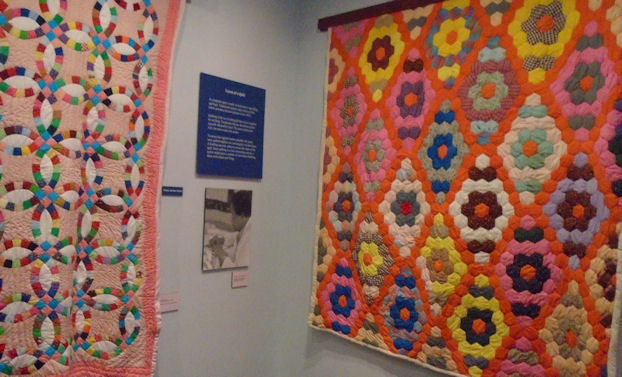
The Anacostia museum was founded in 1967 as a way to reach out to Washington’s African-American community. It remains an important priority to be more inclusive and get more people involved in museums. A museum is not just a place that collects a lot of old stuff. It is a cultural anchor for a community, a place for education and a place to make connections. The Anacostia Museum is especially involved in this sort of outreach.
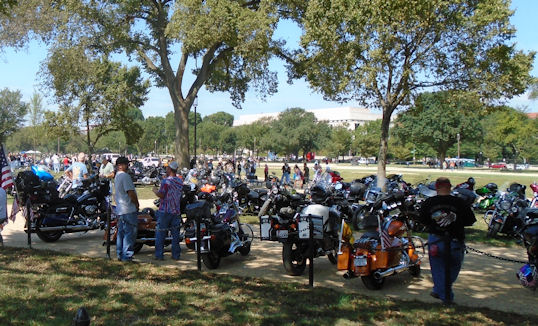
One of their interesting endeavors is the Urban Waterways Project, which aims to help involve communities in the renewal and cleanup of rivers that run through urban areas. Challenges go beyond the the need to clean up. The bigger challenge is to get people involved who have little experience with being involved. An additional caveat is a anxiety that if they make the area too pleasant, it will attract developers who will build luxury apartments or rehab buildings to such an extent that they will become too expensive and drive out the local population.
The ostensible reason I went to Anacostia was to discuss the “Word, Shout, Song” exhibition, which we hope will go to Brazil. It has been translated into Portuguese and is ready to go, but there are logistical and expense considerations.
What is interesting about the exhibition is not the stuff itself, but the research. Lorenzo Dow Turner, a linguist who studied the Gullah language of the South Carolina lowlands. At that time, most people thought Gullah was just bad English. Turner demonstrated the connections between Gullah and West African languages in some grammar and many words. He then went to Brazil and found similar connections in the Brazilian Portuguese of the African diaspora in the Brazil, especially in Bahia and Pernambuco. We hope that this common history can create sustainable connections in Brazil. I am still working for my old post, but also for my assignment.
My picture at top is the Anacostia Community Museum. Below that are some quilts as part of an exhibit. The bottom picture shows motorcycles, part of a demonstration that included thousands of bikers showing solidarity on the anniversary of the 9/11 attacks. Positive & peaceful demonstrations don’t get much media coverage.
Air & Space Museum

I am working to figure out where I might be most useful and it is interesting. I went to the Air & Space Museum. It is very popular with overseas audiences. It is very hard to send actual stuff to partner museums and that is a specialty beyond my skill set. But I do understand outreach and we talked about speaker programs along with poster shows. Smithsonian has recently done a poster show on space suits called Suited for Space, about an exhibit of the same name.
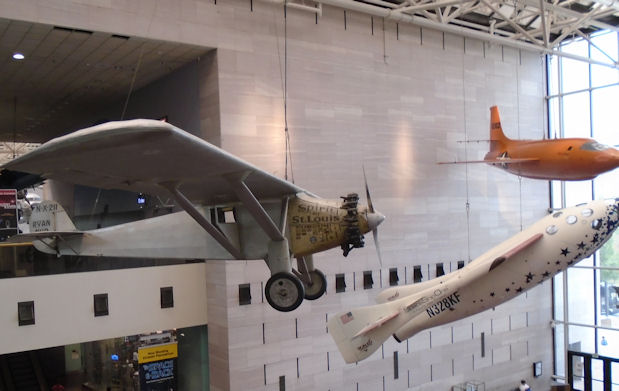
Space suits are interesting. They are made of layers of different metals and plastics and they are bullet proof. They need this because little pieced of stuff are flying around space at high speed, like bullets.
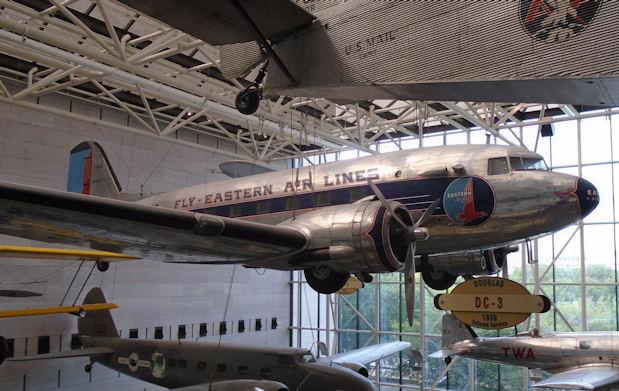
Another interesting thing about space suits is that they are disintegrating. They are produced of layers of plastics and metals. As the plastics decompose, they produce acid that corrodes the suits.

Early space suits were tailor made for the particular astronaut, but today’s space travelers get their suits off the rack. We talked a little about the movie “Gravity.” There are lots of things that are improbable, but one of the impossible things is that an individual cannot just put on or take off space suites.
Of course, there are many other things the museum can produce. We just need to make the connections. That is very simple in theory but not easy in practice.
My pictures are mostly self explanatory. You see the Spirit of St Louis. Charles Lindbergh donated it to Smithsonian with the condition that it never leave. Lindbergh was the world’s leading celebrity in 1927 after he flew alone in that little plane all the way to France.
Flying across the Atlantic was a really big deal that changed the course of history. Before the flight, the U.S. was not a leader in aviation. The Lindbergh flight caught the popular imagination. It is impossible to quantify the effect, but it was significant.
Others were trying to make the crossing.
Aldie Mill – Loudoun County
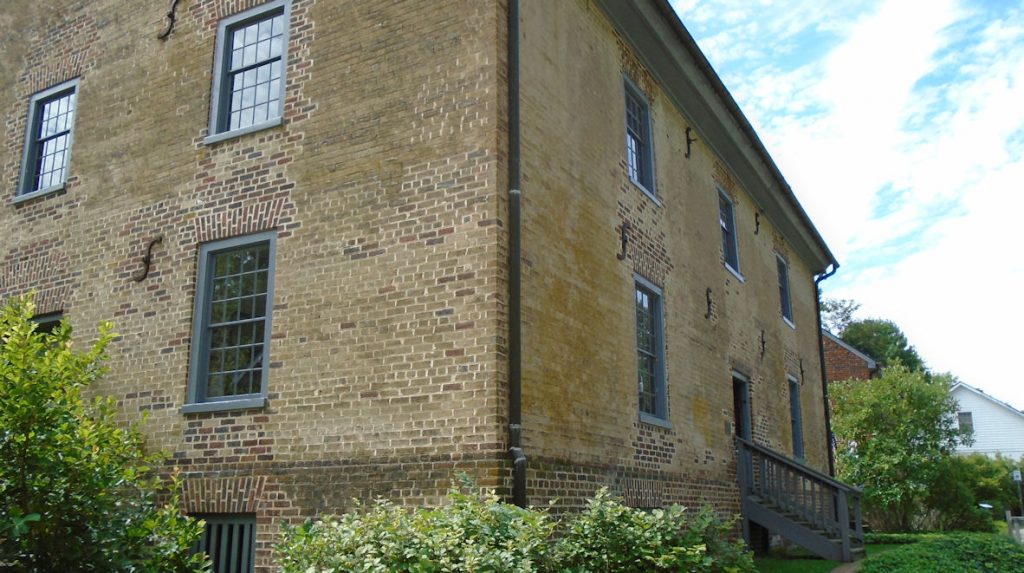
Alex is taking some classes in historical preservation & archeology at the NOVA community college. I have come truly to appreciate community colleges, especially NOVA. They provide well-targeted ways to prepare for specific careers. Alex was assigned to visit Adlie Mill, in Loudoun County. It is in the cute little village of Adlie, maintained in a historical style, very charming.
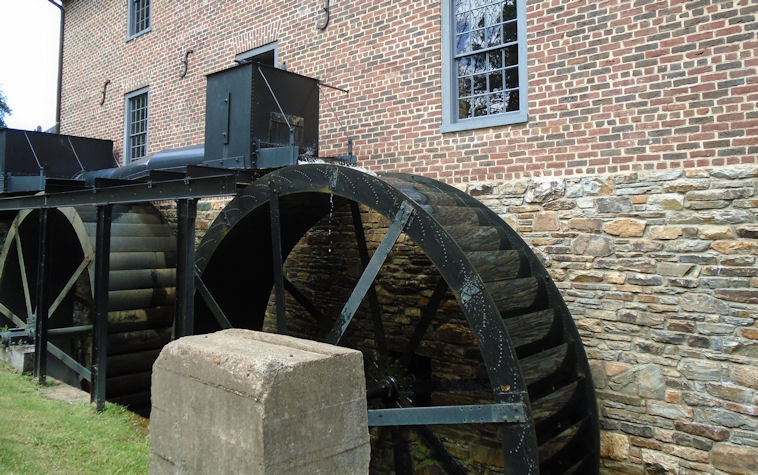
It was a working commercial mill until 1971. It is working still but now as a demonstration project. They grind corn and wheat to make flour and cracked corn that they feed to animals at their farm. This is one of the things I think is important about historical preservation, that they maintain the connections. A mill was not just a place they ground grain; it was integrated into a larger community. It is the connections that are interesting but they can be lost if we preserve only the isolate physical remains.
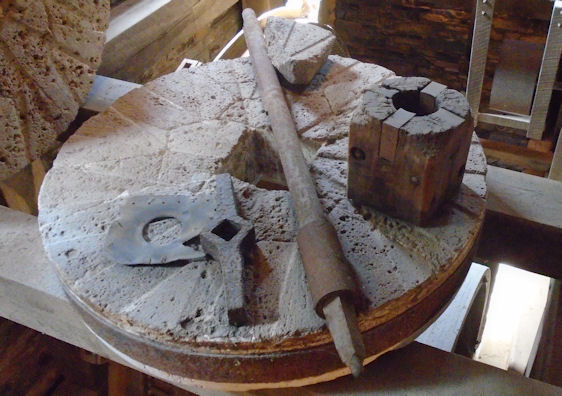
The first guy we met was an engineer volunteer who explained the mechanics of the water wheels & mill stones. The water wheel is an overshot wheel, which means that water is impounded by a dam to create a mill pond. The water is released over the top of the wheel and turned by gravity. Other wheels run by taping the current in rivers. They are undershot wheels. Overshot are usually more powerful, but require the greater investment in dams and ponds.

In the days before steam and gasoline engines – and a while later – industrial operations, like mills needed to be located near fast-flowing water.

The water wheel can turn millstones, saws or anything else that can be hooked up to its mechanical energy. At Adlie they had both, although only the grist mill remains.
We saw the mill stones. They were imported from France because the stone had a good reputation for being hard and durable. They shipped the stone in pieces and reassembled them on site. The stones had groves that cut the grain in a scissors fashion; they did not crush the grains. They adjusted the stones to make finer or courses grains. Adjustments were important: too far apart and no grinding, too close and the stones would bang together knocking pieces of stone into the mix or maybe worse, creating sparks that could set fires in the mills.
Putting in just the right amount of grain was crucial. Too much would clog the operations and cause it to “grind to a halt.” Not enough grain would cause the problems mentioned above. Speed of grinding was also a factor. Too fast would cause friction and fires. The miller used all his senses to get it right. Sound and sight are obvious. Smell was also important. The miller would “put his nose to the grindstone” to figure out if things were getting too hot.
They had some reenactors around this weekend. They specialize in people from the Federal period. One of them told me that there was a need for this. Lots of the physical remains around here were built during that time, but not many people reenact it. Revolutionary times are more popular and the Civil War is the king of hill. The Federalist period was a time of transition. It was early industrial transition and a time of rapid growth in the U.S. There are lots of style choices for reenactors. They can go with the clothes of the revolutionary period, more like the Civil War or various combinations. Transitions are like that.
Among the craftsmen was a guy making cigars. Tobacco was a big part of early American history, as was alcohol. This is something that maybe they need to add back into the historical reproduction, at least in the aspect of smells. Maybe a few farm animals too.

